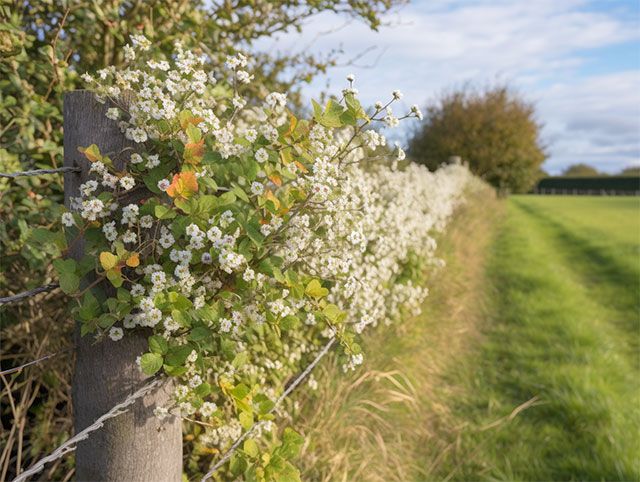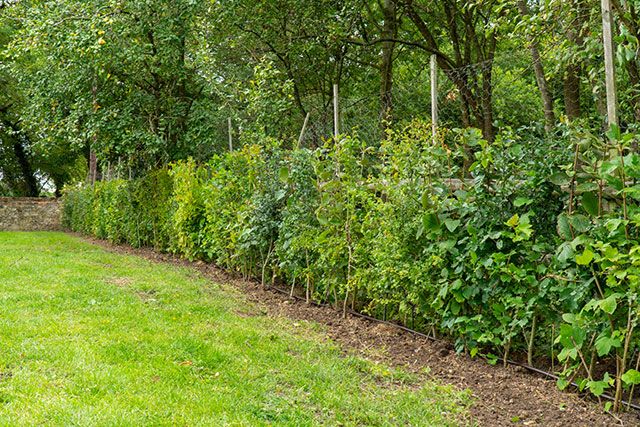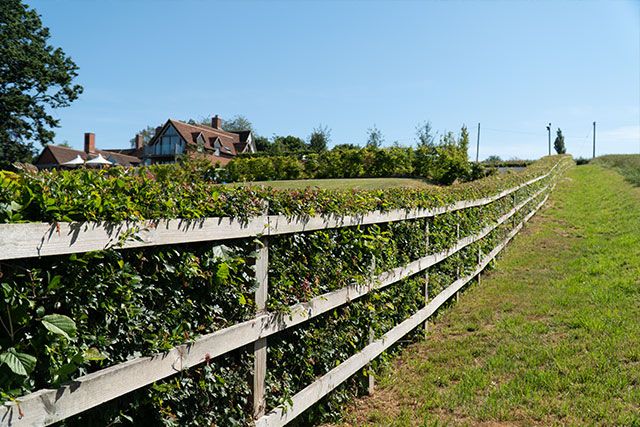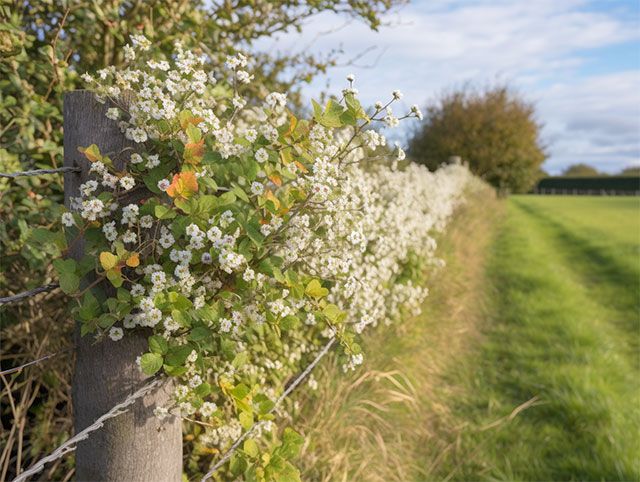Have you ever strolled past a beautifully crafted hedge and marvelled at its ability to provide both an attractive visual barrier and a haven for wildlife? If so, then you may be interested to learn more about native hedge plants in the UK and how they can be used to create a beautiful native mixed hedge.
In this guide, we will explore the benefits of using native plants for hedges, factors to consider when selecting the perfect plants, and eight outstanding native hedge plants suitable for UK gardens. Get ready to transform your garden into a wildlife sanctuary with year round interest and beauty.
Creating the perfect native hedge begins with choosing the right plants.
Native hedges offer numerous benefits, from providing shelter and food for wildlife to creating a beautiful backdrop for gardens.
Factors such as growth rate, soil type, and climate play a crucial role in determining the success of your hedge.
Let's delve deeper into the benefits of native hedges and factors to consider when selecting the ideal plants.

Save time and money with our wide range of Mixed Native Hedging mixes, including Field Wildlife Native Hedging, Garden Wildlife Native Hedging, Thornless Native Hedging, Horse Safe Native Hegding, Pot Grown Native Hedging, Green and Purple Beech Hedging Mix and Countryside Stewardship B11 Native Hedge.
One of the main advantages of native hedges is their ability to support a diverse range of wildlife.
The fundamental conservation hedge mix, predominantly hawthorn supplemented by approximately five other hedge varieties, provides a haven for hundreds of species, from insects to birds and small mammals.
For example, the hawthorn hedge's thorny growth offers shelter for nesting and roosting, while its fruits are a vital food source for birds, particularly during the winter.
Beyond their ecological value, native hedges also hold aesthetic appeal. A well-chosen mix of plants can provide year-round interest in your garden.
Imagine a hedge adorned with white spring flowers, lush green leaves in the summer, and bright red berries in the autumn. The vibrant colours and textures of native hedging plants can create a captivating visual tapestry that enhances the overall beauty of your garden.
When selecting native hedge plants, it's vital to consider the purpose of the hedge.
Do you want it to serve as a boundary, provide privacy, or create a wildlife-friendly habitat? Each plant species offers unique benefits and growth habits, so it's important to select plants that align with your specific goals.
You also need to account for site conditions, such as soil type, climate, and sunlight exposure. For example, hawthorn is a remarkably resilient plant that can thrive in various climates and withstand cold winds and temperatures dropping below -20°C.
By choosing plants that are well-suited to your garden's conditions, you will increase the likelihood of your native hedge thriving and fulfilling its intended purpose.
Now that we've covered the benefits of native hedges and factors to consider when selecting plants for garden hedges, let's explore ten outstanding native hedge plants for UK gardens.
These plants include hawthorn, hazel, purple or copper beech, blackthorn, dogwood, box hedge, holly, and hornbeam.
Each plant offers its own unique characteristics and benefits, making most soils them ideal candidates for creating a diverse and thriving native hedge.

Hawthorn hedge is a quintessential native hedge plant in the UK. It boasts dense growth, thorny branches, and a remarkable ability to support hundreds of wildlife species.
When planting a hedge, it's essential to dig a trench twice the width of the root ball and ensure the hedge is adequately hydrated.
Pruning should be carried out in late winter or early spring to facilitate new growth.
With its robust nature and wildlife-friendly characteristics, hawthorn is an excellent choice for any native hedge.
If you're looking for a fast-growing native hedge plant, hazel hedge is an ideal choice.
Its vigorous growth allows it to reach heights of up to 10 feet within a few years. Hazel is also a versatile plant that offers flexibility, wildlife value, and privacy.
When planting hazel, consider the soil type, climate, and sunlight exposure to ensure optimal growth.
With its rapid growth rate and numerous benefits, hazel is a fantastic option for UK gardens.
Green Beech and Purple or Copper Beech is a popular native hedge plant due to its glossy foliage, autumnal hue, and its ability to support a variety of wildlife species.
Its leaves turn from a vibrant green to a coppery-bronze in the autumn, adding visual interest to your garden throughout the year.
Beech is also fast-growing, making it ideal for screening and privacy purposes.
With its aesthetically pleasing foliage and wildlife support, beech is a top choice for UK gardens.
Blackthorn hedging is a dense, wildlife-friendly native hedge plant that can accommodate various planting positions and sun exposure levels, making it ideal for wildlife gardens or hedgerows.
Its thorny branches provide protection for nesting birds, while its white blossoms attract pollinating insects in the spring.
Blackthorn's ability to attract a diverse array of wildlife makes it a valuable addition to any native hedge.
Dogwood hedge is a wonderful choice for adding winter interest to your native hedge.
Its vivid, gleaming red, orange and yellow stems enliven your hedge during the colder months.
In addition to its visual appeal, dogwood also provides sustenance for birds, small mammals, and other wildlife.
Its combination of winter beauty and wildlife value make dogwood a popular native hedge plant in the UK.
English Holly Hedging is a favourite for festive charm and bird shelter.
Its evergreen nature provides year-round interest and winter coverage, making it an excellent choice for native hedges.
Holly is also beloved by birds, pollinating insects, and hedgehogs, offering ample wildlife value.
With its festive charm and ability to provide shelter for birds, holly is a delightful addition to any native hedge.
Hornbeam hedge is a robust native hedge plant that offers exceptional wildlife habitat and can withstand various growing conditions.
Its dense foliage creates an ideal nesting site, and its leaves remain throughout winter, providing shelter and security for garden wildlife during the colder months.
Hornbeam is also highly sturdy and can endure poor growing conditions such as full shade, windy areas, and clay or saturated soils.
Its toughness and wildlife support make hornbeam a reliable choice for UK gardens.
Guelder Rose Hedge, also known as Viburnum opulus, is an attractive deciduous hedging species that provides seasonal interest, with fragrant, white lace-cap flowers in spring and large, ornate green leaves that turn red in the autumn.
Guelder Rose produces large clusters of juicy red berries that are a hit with birds.
Viburnum opulus works very well as part of a species rich, mixed native hedge.
Now that we've covered the benefits of native hedges and factors to consider when selecting plants for garden hedges, let's explore eight outstanding native hedge plants for UK gardens.
Each plant offers its own unique characteristics and benefits, making most soils them ideal candidates for creating a diverse and thriving native hedge.
Planting and caring for your native hedge involves proper planting techniques, regular watering and feeding, and timely pruning and shaping.
By following the best practices for each of these aspects, you can ensure that your native hedge thrives and remains a beautiful and functional part of your garden.

To create a thriving native hedge, it's essential to use proper planting techniques. For native hedging plants of 60/80 cms or less, slit planting is the most effective method. When planting, be sure to space the plants 45cm (18in) apart in each row and stagger them in a double row with 30cm (12in) spacing between rows. This will ensure a thick, lush hedge.
In addition to growing tips and using the correct planting method, it's important to plant your native hedge during the optimal planting season. For most native hedge plants, autumn and winter are the best times to plant, as this allows the plants to establish their root systems before the growing season begins.
Proper watering is crucial for the success of your native hedge. For recently planted native hedge plants, administer a thorough watering of 5-10 litres of water once or twice a week. Water deeply a few times a week rather than lightly and regularly, as this will encourage the development of a strong root system.
Once young plants are established, hedges typically do not require additional watering.
Pruning and shaping your native hedge is essential for maintaining its desired size and shape, as well as promoting healthy growth. Late summer pruning is recommended, with a slight angle cut wider at the base to allow light to reach the lower branches.
Be sure to avoid pruning during spring or summer, as this can disrupt nesting birds and other wildlife. By following proper pruning and shaping hedging techniques, you can ensure the health and longevity of your native hedge.
A mixed native hedge combines multiple native plant species, offering a host of advantages such as shelter, food, and nesting sites for wildlife.
Choose from a wide variety of hedging mixes, including Field Wildlife Hedging Mix, Garden Wildlife Hedging Mix, Horse Safe Hedging Mix and Thornless Mixed Hedges.
By selecting complementary species and employing optimal planting arrangements, you can create a lush, diverse native hedge that supports wildlife conservation efforts.

Our popular UK native hedging mixes offer the easiest way to start a new native hedgerow. Pre mixed with a selection of high quality native plants.
When selecting complementary species for your mixed native hedge, it's important to consider the growth habits and characteristics of each species, as well as the site conditions.
By choosing plants that are compatible and thrive in the specified environment, you can ensure a successful mixed native hedge.
For example, hawthorn, blackthorn, field maple, beech, hornbeam, and holly all provide excellent wildlife habitat and can be combined in a mixed native hedge.
To create a thick, visually appealing mixed native hedge, it's essential to use proper planting arrangements.
Plant the trees and shrubs in a staggered double row, with each row 30cm (12in) apart and plants 45cm (18in) apart in each row. This will ensure a dense, lush hedge that provides ample shelter and nesting sites for wildlife.
Keep the ground under the hedge clear of weeds until the plants cast enough shade. This will help prevent weed growth in thicker hedge in the future.
Mixed native hedges combine various native plant species to create a diverse and thriving habitat for a range of wildlife. Instant hedging, which involves the use of pre-grown plants in a hedge, offers several benefits for those looking to create a mixed native hedge quickly.
One advantage of instant mixed hedging is its convenience. The plants are pre-grown, allowing quick installation and establishment of the hedge.
Instant hedging requires less maintenance than traditional hedge planting, as the plants are already established, reducing the likelihood of plant death and the need for replacement.
Instant hedging also offers an instant visual impact, creating a well-established hedge that offers immediate functional and aesthetic benefits.
This is ideal for those looking to create an instant, wildlife-friendly boundary or a striking garden feature.
Creating a mixed native hedge with complementary species not only enhances the visual appeal of your garden, but also supports wildlife conservation efforts.
By selecting species that attract wildlife, such as evergreen shrubs, deciduous trees, and climbers, you can create a thriving native hedge that provides valuable habitat for a diverse range of creatures.
Additionally, you can include rambling plants such as wild rose, bramble, and honeysuckle to further enhance the shelter and sustenance available for wildlife within your hedge.
In conclusion, native hedge plants offer a wealth of benefits for UK gardens, from providing year-round beauty and wildlife habitat to serving as a functional and aesthetically pleasing barrier.
By carefully selecting the right plants, employing proper planting techniques, and caring for your native hedge, you can create a thriving, diverse native hedgerow, that will enhance your garden and support local wildlife.
So why not embark on the journey of creating your very own native hedge and witness the wonders it can bring to your garden and local ecosystem?
RELATED ARTICLES - native mixed hedging
Published on 06 June 2023 By Will Bodsworth